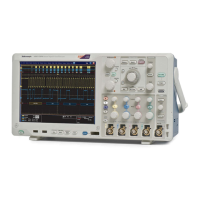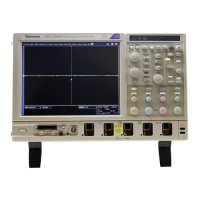Set the Time-Out value
The time-out value determines when the instrument will trigger.
1. Click in the Timer entry box.
2. Use the multipurpose knob to set the time-out value.
Set the upper and lower threshold levels for transition time
Use the upper and lower threshold levels to measure the transition time as shown in the trigger graphic.
1. Click in the Upper Level entry box and use the multipurpose knob to set the voltage level.
2. Click in the Lower Level entry box and use the other multipurpose knob to set the voltage level.
Set the transition time trigger criteria
1. Click in the Time entry box and use the multipurpose knob to set the target transition time.
2. Click in the Transition entry box.
■
<. Triggers the instrument when the transition time is less than the specified time.
■
Greater Than. Triggers the instrument when the transition time is greater than the specified time.
Trigger coupling
The trigger coupling determines what part of the signal is passed to the trigger circuitry. All trigger types except edge triggering
use DC coupling only. Edge triggering can use all available coupling choices.
■
DC. This coupling passes all input signals to the trigger circuitry.
■
AC. This coupling passes the input signals above 60 Hz to the trigger circuitry.
■
HF Reject. This coupling attenuates signals above 50 kHz before passing the signal to the trigger circuitry.
■
LF Rej. This coupling attenuates signals below 80 kHz before passing the signal to the trigger circuitry.
■
Noise Rej. This coupling provides stable triggering by increasing the trigger hysteresis. Increased hysteresis reduces the
trigger sensitivity to noise but may require greater signal amplitude.
■
RF. Increases sensitivity and bandwidth at the highest operating frequencies (SX models only).
Set the glitch width criteria
These controls specify the action of the glitch width criteria. The trigger graphic displays the criteria you have selected.
1. Click in the Width entry box and set the width with the multipurpose knob.
2. Use the Glitch Width drop-down list box to specify the action:
■
Less Than. Triggers the instrument only on glitches narrower than the specified width
■
Greater Than. Triggers the instrument only on pulses wider than the specified width.
Trigger graticule
All graticule types are available for selection from the drop-down list. The IRE graticule is normally used with the NTSC signals,
and the mV graticule is normally used with all other video signals.
Trigger holdoff (Auto)
When the Trigger Holdoff is set to Auto, the instrument automatically calculates the trigger holdoff time. It is normally equal to five
times the current Horizontal Scale setting.
Oscilloscope reference
834 DPO70000SX, MSO/DPO70000DX, MSO/DPO70000C, DPO7000C, and MSO/DPO5000B Series

